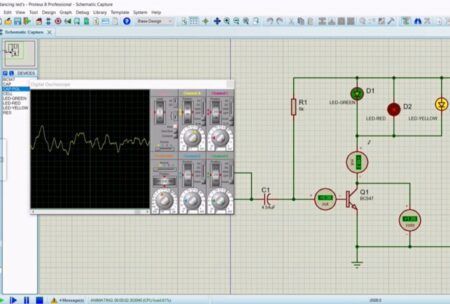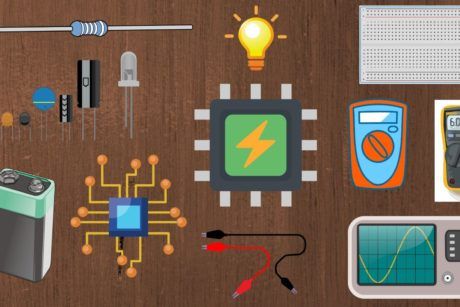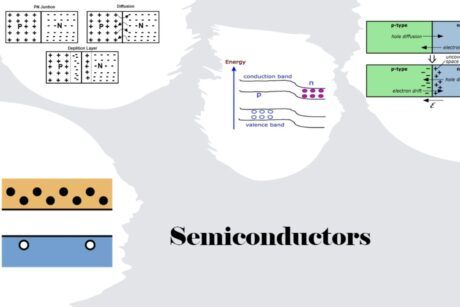Learn how to design and simulate transistor circuits on Proteus software with this course. Master the fundamentals of analog electronics. Enroll now! Read more.
Meet Swarit Mahalsekar, the Biomedical engineer who has made it his mission to share his knowledge and skills in electronics with the world. As an experienced online instructor on multiple platforms, Swarit has helped countless students master the art of electronics. But that's not all – Swarit's passion for teaching led him to found "Practical Buddy," a platform dedicated to providing students with practical, hands-on experience in electronics. With his extensive background in completing e
Access all courses in our library for only $9/month with All Access Pass
Get Started with All Access PassBuy Only This CourseAbout This Course
Who this course is for:
- This course suits biomedical, electrical, electronics, instrumentation, and robotics engineering students.
- Curious minds eager to understand transistors, their functions, and applications.
- Individuals with an interest in learning electronics from the ground up.
- Enthusiasts seeking knowledge in analog electronics.
What you’ll learn:
- Gain clarity on the fundamentals of transistors.
- Identify various types of transistors.
- Skillfully design and analyze BJT circuits using Proteus.
- Simulate BJT circuits effectively with Proteus software.
- Grasp the concept of biasing and its necessity in transistor circuits.
- Practice circuit simulation using Proteus.
- Understand the characteristics of transistors.
- Apply biasing techniques through numerical exercises.
- Model BJT transistors proficiently.
- Use transistors as switches.
- Create amplifiers using transistors.
- Embark on three mini-projects centered around transistors.
Requirements:
- Basic comprehension of electrical circuits, including KVL, KCL, Nodal analysis, and circuit theorems. If unfamiliar, consider enrolling in “Current Electricity In Depth And Basics Of DC Circuits” to master these concepts.
- Comprehensive understanding of semiconductors. If you are a complete beginner, you can take my course “Semiconductors And Its Application In Analog Electronics“.
- Sound knowledge of diodes and diode circuits. If you are a complete beginner, you can take my course “Analog Electronics For Beginners – Simulating Circuits On Electric Circuit Studio“.
- Access to Proteus software for download.
Every time you swipe your smartphone screen, marvel at the tiny miracles powering its intelligence – transistors. These microscopic wonders, switching on and off at lightning speed, serve as the backbone of modern electronics. Picture this: you wish to monitor your heart’s electrical activity using electrodes. You’ll need a circuit to filter and amplify the signal, made possible by transistors.
Do you dream of controlling a robot or a toy motor? You’ll require a circuit capable of toggling the motor, again facilitated by transistors. Even your smartphone’s complex computations owe gratitude to these electronic workhorses. Logic gates, crucial for processing binary data, are constructed using transistors.
Transistors are indispensable across various engineering domains, from biomedical to robotics. Hence, this course is designed to simplify their workings and unveil their versatile applications. Join us on this transformative journey and become a master of transistors in the realm of electronics.
Our Promise to You
By the end of this course, you will have learned about transistors and circuit simulation.
10 Day Money Back Guarantee. If you are unsatisfied for any reason, simply contact us and we’ll give you a full refund. No questions asked.
Get started today!
Course Curriculum
| Section 1 - Introduction | |||
| Course Trailer | 00:00:00 | ||
| Introduction | 00:00:00 | ||
| Importance Or Application Of Transistors | 00:00:00 | ||
| Section 2 - Understanding Basic Concepts Of Transistors | |||
| Definition Of Transistors | 00:00:00 | ||
| Types Of Transistors | 00:00:00 | ||
| Section 3 - Introduction To BJT Transistors | |||
| Symbol And Construction Of BJT Transistor | 00:00:00 | ||
| Why The Area Of Collector Region Is Greater Than The Emitter Region | 00:00:00 | ||
| Why NPN Transistor Is Preferred Over PNP? | 00:00:00 | ||
| Recognizing Terminals Of BJT | 00:00:00 | ||
| Configurations Of BJT | 00:00:00 | ||
| Understanding The Definition Of Transistor In Depth | 00:00:00 | ||
| Difference Between Ground And Negative Potential In Electronic Circuits | 00:00:00 | ||
| Introduction To Proteus Software | 00:00:00 | ||
| Section 4 - Input Characteristics Of BJT | |||
| Introduction To Input Characteristic And Understanding Case 1 | 00:00:00 | ||
| Simulating Case 1 On The Proteus Software And Plotting The Results On The Graph | 00:00:00 | ||
| Input Characteristic And Understanding Case 2 | 00:00:00 | ||
| Simulating Case 2 On The Proteus Software And Plotting The Results On The Graph | 00:00:00 | ||
| Section 5 - Output Characteristics Of BJT | |||
| Introduction To Output Characteristic And Understanding Case 1 | 00:00:00 | ||
| Simulating Case 1 On The Proteus Software And Plotting The Results On The Graph | 00:00:00 | ||
| Understanding And Simulating Case 2 On The Proteus Software | 00:00:00 | ||
| Section 6 - What Is Beta Or Current Gain Of Transistor? | |||
| Understanding The Concept Of The Current Gain | 00:00:00 | ||
| Section 7 - What Are The Different Operating Regions Of Transistors? | |||
| Understanding How BJT Can Be Operated In Saturation, Cutoff And Active Region | 00:00:00 | ||
| Section 8 - What Is Biasing And Need Of Biasing Transistors | |||
| What Is Biasing? | 00:00:00 | ||
| Understand The Concept Of Load-Line And Q-Point | 00:00:00 | ||
| Why Transistors Are Biased? | 00:00:00 | ||
| Section 9 - Biasing Techniques Of Transistors | |||
| Fixed Biasing Technique | 00:00:00 | ||
| Modified Fixed Bias | 00:00:00 | ||
| Collector To Base Bias And Understanding Why It Is Known As A Self Bias Circuit | 00:00:00 | ||
| Voltage Divider Bias Technique | 00:00:00 | ||
| Why Voltage Divider Bias Is Known As Self Bias Circuit | 00:00:00 | ||
| Why There Is 180 Degree Phase Shift Between Input And Output Signal Of BJT | 00:00:00 | ||
| Section 10 - What Is Stability Factor? | |||
| Definition Of Stability Factor | 00:00:00 | ||
| Derivation Of Stability Factor | 00:00:00 | ||
| Stability Factor For Different Biasing Techniques | 00:00:00 | ||
| Section 11 - Numericals | |||
| Numerical 1 | 00:00:00 | ||
| Numerical 2 | 00:00:00 | ||
| Numerical 3 | 00:00:00 | ||
| Section 12 - Mini-Project | |||
| Automated Brightness Controller Project 1 | 00:00:00 | ||
| Automatic Street Light Controller Project 2 | 00:00:00 | ||
| Implementing The Concept Of DJ Lights | 00:00:00 | ||
| Section 13 - Understanding Different Sources | |||
| Types Of Sources | 00:00:00 | ||
| Independent Ideal And Practical Voltage Source | 00:00:00 | ||
| Independent Ideal And Practical Current Source | 00:00:00 | ||
| Dependent Sources | 00:00:00 | ||
| Section 14 - Numericals On Dependent Sources | |||
| Numerical 1 | 00:00:00 | ||
| Numerical 2 | 00:00:00 | ||
| Numerical 3 | 00:00:00 | ||
| Section 15 - Two Port Network And It's Application While Designing An Amplifier With BJT | |||
| Major Parameters Required For Designing Any Amplifier | 00:00:00 | ||
| BJT As 2-Port Network | 00:00:00 | ||
| Z-Parameter Or Open Circuit Impedance | 00:00:00 | ||
| Y-Parameter Or Short Circuit Admittance Parameter | 00:00:00 | ||
| ABCD-Parameter Or Transmission Parameter | 00:00:00 | ||
| H-Parameter Or Hybrid(Mixed)-Parameter | 00:00:00 | ||
| Section 16 - T-Model Of BJT | |||
| What Is The Significance Of T-Model Over H-Model? | 00:00:00 | ||
| Section 17 - R-Pi Model Of BJT | |||
| Introduction To R-Pi Model And Its Significance Over H And T-Model | 00:00:00 | ||
| Parameters Involved In R-Pi Model | 00:00:00 | ||
| Section 18 - Understanding And Analyzing Different Parameters To Design A CE Amplifier | |||
| Why Capacitor Is Connected Parallel To Emitter Resistance | 00:00:00 | ||
| Analyzing CE Amplifier | 00:00:00 | ||
| Section 19 - Numerical On BJT Amplifier | |||
| DC Analysis | 00:00:00 | ||
| AC Analysis | 00:00:00 | ||
| Section 20 - Understanding The Use Of Function Generator And Oscilloscope | |||
| What Is Function Generator And Oscilloscope | 00:00:00 | ||
| Implementing And Simulating Function Generator And Oscilloscope On Proteus Software | 00:00:00 | ||
| Understanding The Operation Of Four Voltage Channels Of Oscilloscope. | 00:00:00 | ||
| How To Calculate Voltage And Frequency Of Any Signal Using Oscilloscope | 00:00:00 | ||
| Section 21 - How To Design And Simulate CE Amplifier | |||
| Designing Of CE Amplifier Part 1 | 00:00:00 | ||
| Designing Of CE Amplifier Part 2 | 00:00:00 | ||
| Designing Of CE Amplifier Part 3 | 00:00:00 | ||
| Designing Of CE Amplifier Part 4 | 00:00:00 | ||
| Designing Of CE Amplifier Part 5 | 00:00:00 | ||
About This Course
Who this course is for:
- This course suits biomedical, electrical, electronics, instrumentation, and robotics engineering students.
- Curious minds eager to understand transistors, their functions, and applications.
- Individuals with an interest in learning electronics from the ground up.
- Enthusiasts seeking knowledge in analog electronics.
What you’ll learn:
- Gain clarity on the fundamentals of transistors.
- Identify various types of transistors.
- Skillfully design and analyze BJT circuits using Proteus.
- Simulate BJT circuits effectively with Proteus software.
- Grasp the concept of biasing and its necessity in transistor circuits.
- Practice circuit simulation using Proteus.
- Understand the characteristics of transistors.
- Apply biasing techniques through numerical exercises.
- Model BJT transistors proficiently.
- Use transistors as switches.
- Create amplifiers using transistors.
- Embark on three mini-projects centered around transistors.
Requirements:
- Basic comprehension of electrical circuits, including KVL, KCL, Nodal analysis, and circuit theorems. If unfamiliar, consider enrolling in “Current Electricity In Depth And Basics Of DC Circuits” to master these concepts.
- Comprehensive understanding of semiconductors. If you are a complete beginner, you can take my course “Semiconductors And Its Application In Analog Electronics“.
- Sound knowledge of diodes and diode circuits. If you are a complete beginner, you can take my course “Analog Electronics For Beginners – Simulating Circuits On Electric Circuit Studio“.
- Access to Proteus software for download.
Every time you swipe your smartphone screen, marvel at the tiny miracles powering its intelligence – transistors. These microscopic wonders, switching on and off at lightning speed, serve as the backbone of modern electronics. Picture this: you wish to monitor your heart’s electrical activity using electrodes. You’ll need a circuit to filter and amplify the signal, made possible by transistors.
Do you dream of controlling a robot or a toy motor? You’ll require a circuit capable of toggling the motor, again facilitated by transistors. Even your smartphone’s complex computations owe gratitude to these electronic workhorses. Logic gates, crucial for processing binary data, are constructed using transistors.
Transistors are indispensable across various engineering domains, from biomedical to robotics. Hence, this course is designed to simplify their workings and unveil their versatile applications. Join us on this transformative journey and become a master of transistors in the realm of electronics.
Our Promise to You
By the end of this course, you will have learned about transistors and circuit simulation.
10 Day Money Back Guarantee. If you are unsatisfied for any reason, simply contact us and we’ll give you a full refund. No questions asked.
Get started today!
Course Curriculum
| Section 1 - Introduction | |||
| Course Trailer | 00:00:00 | ||
| Introduction | 00:00:00 | ||
| Importance Or Application Of Transistors | 00:00:00 | ||
| Section 2 - Understanding Basic Concepts Of Transistors | |||
| Definition Of Transistors | 00:00:00 | ||
| Types Of Transistors | 00:00:00 | ||
| Section 3 - Introduction To BJT Transistors | |||
| Symbol And Construction Of BJT Transistor | 00:00:00 | ||
| Why The Area Of Collector Region Is Greater Than The Emitter Region | 00:00:00 | ||
| Why NPN Transistor Is Preferred Over PNP? | 00:00:00 | ||
| Recognizing Terminals Of BJT | 00:00:00 | ||
| Configurations Of BJT | 00:00:00 | ||
| Understanding The Definition Of Transistor In Depth | 00:00:00 | ||
| Difference Between Ground And Negative Potential In Electronic Circuits | 00:00:00 | ||
| Introduction To Proteus Software | 00:00:00 | ||
| Section 4 - Input Characteristics Of BJT | |||
| Introduction To Input Characteristic And Understanding Case 1 | 00:00:00 | ||
| Simulating Case 1 On The Proteus Software And Plotting The Results On The Graph | 00:00:00 | ||
| Input Characteristic And Understanding Case 2 | 00:00:00 | ||
| Simulating Case 2 On The Proteus Software And Plotting The Results On The Graph | 00:00:00 | ||
| Section 5 - Output Characteristics Of BJT | |||
| Introduction To Output Characteristic And Understanding Case 1 | 00:00:00 | ||
| Simulating Case 1 On The Proteus Software And Plotting The Results On The Graph | 00:00:00 | ||
| Understanding And Simulating Case 2 On The Proteus Software | 00:00:00 | ||
| Section 6 - What Is Beta Or Current Gain Of Transistor? | |||
| Understanding The Concept Of The Current Gain | 00:00:00 | ||
| Section 7 - What Are The Different Operating Regions Of Transistors? | |||
| Understanding How BJT Can Be Operated In Saturation, Cutoff And Active Region | 00:00:00 | ||
| Section 8 - What Is Biasing And Need Of Biasing Transistors | |||
| What Is Biasing? | 00:00:00 | ||
| Understand The Concept Of Load-Line And Q-Point | 00:00:00 | ||
| Why Transistors Are Biased? | 00:00:00 | ||
| Section 9 - Biasing Techniques Of Transistors | |||
| Fixed Biasing Technique | 00:00:00 | ||
| Modified Fixed Bias | 00:00:00 | ||
| Collector To Base Bias And Understanding Why It Is Known As A Self Bias Circuit | 00:00:00 | ||
| Voltage Divider Bias Technique | 00:00:00 | ||
| Why Voltage Divider Bias Is Known As Self Bias Circuit | 00:00:00 | ||
| Why There Is 180 Degree Phase Shift Between Input And Output Signal Of BJT | 00:00:00 | ||
| Section 10 - What Is Stability Factor? | |||
| Definition Of Stability Factor | 00:00:00 | ||
| Derivation Of Stability Factor | 00:00:00 | ||
| Stability Factor For Different Biasing Techniques | 00:00:00 | ||
| Section 11 - Numericals | |||
| Numerical 1 | 00:00:00 | ||
| Numerical 2 | 00:00:00 | ||
| Numerical 3 | 00:00:00 | ||
| Section 12 - Mini-Project | |||
| Automated Brightness Controller Project 1 | 00:00:00 | ||
| Automatic Street Light Controller Project 2 | 00:00:00 | ||
| Implementing The Concept Of DJ Lights | 00:00:00 | ||
| Section 13 - Understanding Different Sources | |||
| Types Of Sources | 00:00:00 | ||
| Independent Ideal And Practical Voltage Source | 00:00:00 | ||
| Independent Ideal And Practical Current Source | 00:00:00 | ||
| Dependent Sources | 00:00:00 | ||
| Section 14 - Numericals On Dependent Sources | |||
| Numerical 1 | 00:00:00 | ||
| Numerical 2 | 00:00:00 | ||
| Numerical 3 | 00:00:00 | ||
| Section 15 - Two Port Network And It's Application While Designing An Amplifier With BJT | |||
| Major Parameters Required For Designing Any Amplifier | 00:00:00 | ||
| BJT As 2-Port Network | 00:00:00 | ||
| Z-Parameter Or Open Circuit Impedance | 00:00:00 | ||
| Y-Parameter Or Short Circuit Admittance Parameter | 00:00:00 | ||
| ABCD-Parameter Or Transmission Parameter | 00:00:00 | ||
| H-Parameter Or Hybrid(Mixed)-Parameter | 00:00:00 | ||
| Section 16 - T-Model Of BJT | |||
| What Is The Significance Of T-Model Over H-Model? | 00:00:00 | ||
| Section 17 - R-Pi Model Of BJT | |||
| Introduction To R-Pi Model And Its Significance Over H And T-Model | 00:00:00 | ||
| Parameters Involved In R-Pi Model | 00:00:00 | ||
| Section 18 - Understanding And Analyzing Different Parameters To Design A CE Amplifier | |||
| Why Capacitor Is Connected Parallel To Emitter Resistance | 00:00:00 | ||
| Analyzing CE Amplifier | 00:00:00 | ||
| Section 19 - Numerical On BJT Amplifier | |||
| DC Analysis | 00:00:00 | ||
| AC Analysis | 00:00:00 | ||
| Section 20 - Understanding The Use Of Function Generator And Oscilloscope | |||
| What Is Function Generator And Oscilloscope | 00:00:00 | ||
| Implementing And Simulating Function Generator And Oscilloscope On Proteus Software | 00:00:00 | ||
| Understanding The Operation Of Four Voltage Channels Of Oscilloscope. | 00:00:00 | ||
| How To Calculate Voltage And Frequency Of Any Signal Using Oscilloscope | 00:00:00 | ||
| Section 21 - How To Design And Simulate CE Amplifier | |||
| Designing Of CE Amplifier Part 1 | 00:00:00 | ||
| Designing Of CE Amplifier Part 2 | 00:00:00 | ||
| Designing Of CE Amplifier Part 3 | 00:00:00 | ||
| Designing Of CE Amplifier Part 4 | 00:00:00 | ||
| Designing Of CE Amplifier Part 5 | 00:00:00 | ||



